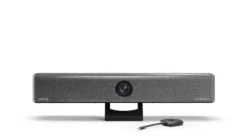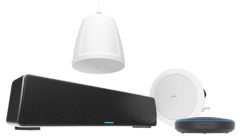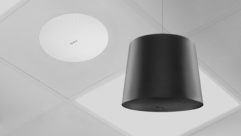
Loudspeakers Join The Network
Another piece falls into place in the IT integration puzzle.
Soaring above the congregation at the Henderson Hills Baptist Church in Edmond, OK, is a network of flown loudspeakers. Dale Alexander, principal consultant of Creative Technologues Consulting, a division of AVL Systems Design, Edmond, OK, is shown tweaking the network connections from one of two scissor lifts the church owns.
Credit: Travis Duncan
There’s no doubt that AV/IT convergence has shifted the way systems integrators think about audio and video. Rather than standalone devices, AV products are increasingly seen as “network appliances.” On the audio side of the equation, an increasing number of manufacturers are joining the party with what are commonly called “networkable loudspeakers.” But in reality this term is a bit of a misnomer, as no passive loudspeaker in the conventional sense can exist and/or function on any sort of a network without a little help.
This help comes in the form of self-power — the integration of power amplifier(s) within the loudspeaker cabinet. Usually, these amplifiers are designed to work optimally with the transducers, and are joined by a tailored electronics package. All of these elements combine to form a true loudspeaker system.
“Loudspeakers are no more networkable than they are digital,” says John Murray of ProSonic Solutions, Woodland Park, CO. “For something to be networked, it must be an active system — electronic and powered in some way. When we’re talking about a loudspeaker being ‘networked,’ we’re really referring to the amplifier being on the network. Therefore, it would be more accurate to talk about powered loudspeakers with network capability.”
A Renkus-Heinz PowerNet module outfitted with amplification and ports for R-control and CobraNet.
Coming up on 30 years of experience with both the system integrator and manufacturing sides of the professional audio business, Murray has spent a good amount of time dealing with the concept of networking. In fact, he was on the team at TOA Electronics when that company rolled out the earliest dedicated digital signal processing (DSP) system for true commercial audio applications, and has kept close tabs on the development process ever since.
“Another difficulty comes with the definition of the term ‘network,’ and further, contrasting that with the continued development of many of the ‘computer-controlled’ powered loudspeaker packages,” Murray adds. “In a loose sense, any time you connect a number of devices together, it’s a network. Even a traditional telephone system is a network, albeit in the analog domain, and most of the powered loudspeakers interfacing with computers are doing do so in analog as well, usually via serial control data formats such as RS422 and RS485.”
When it comes to networkable loudspeakers, a quick history lesson is in order to see where the industry stands before exploring where we go from here.
Time machine
Fifteen or so years ago, the buzz was “processed” loudspeakers, where higher end products from numerous companies were supplied with dedicated outboard signal processors and suggested optimized settings. Next came powered loudspeakers viable for mainstream commercial applications, led by companies such as Meyer Sound, an approach that’s steadily proliferated. (Note, however, that the self-powered concept was first available all the way back in the 1960s.)
Concurrently, computer control scenarios were being devised for power amplifiers, led by Crown with the IQ System. This technology development process continues. One facet of this capability provided the ability to monitor certain loudspeaker parameters such as temperature and driver failure. Just a bit later, digital signal processors that are network addressable debuted and continue to progress, interfacing with a computer for control and monitoring.
These developments lead us to the present, where all of the various specialties are being amalgamated into loudspeakers outfitted with power amplifiers and processing that’s user-adjustable (and in some cases is still analog based). Now, the ability to interface a computer with power/DSP modules designed within the loudspeaker as a module, for various degrees of control and monitoring, is possible — all with software interfaces offering a user-friendly Windows environment.
In tandem with this trend has come the ability to also transmit the audio signal in the digital domain via a network to the amplifier. Leaders in this approach have been Cirrus Logic (Peak Audio) CobraNet and Digigram EtherSound, both of which have numerous component manufacturers committed as licensees of their respective protocols.
Upside, downside
“We’ve done many projects — and are in the process of doing more — headed by loudspeakers with networking capability,” says Dale Alexander of Creative Technologies Consulting, a division of AVL Systems Design, an AV consulting and integration firm located in Edmond, OK. “That said, the ability to provide audio on a network doesn’t do anything special right now for smaller applications. It’s just another way to facilitate getting audio out.“
However, he maintains there’s still an economy of scale, where the audio system needs to be fairly large before it makes sense. “It’s an advantage to distribute audio on Cat5 and go from node to node instead of having to use huge quantities of heavy-gauge twisted-pair loudspeaker cable,” he says. “This can cut some of the cabling and conduit cost and hassle, plus there’s the convenience that it’s IP addressable.”
Alexander believes the audio industry will see more applications of loudspeaker networking in the future. “It’s important to keep in mind that there are numerous situations at present, particularly those of a smaller scale, where it’s not the right approach,” he says. “At the same time, lesser-scale systems should be looked at in terms of future expansion capability, where a networked approach can be the right call in terms of function and cost when the system indeed grows. It’s our job to guide clients to a clear understanding of all of these issues.”
Citing situations where the loudspeaker locations are tough to access after installation (say 40 feet above floor level), Alexander says any changes or problems after installation in these types of scenarios can present both added hassle and expense. “Significant problems happening after the install aren’t that helpful when it comes to the maintenance budget,” Alexander says. “And it’s when you’d really prefer your amps and DSP to be located at ground level.”
Slow and steady
David Rahn, national sales manager for commercial loudspeaker maker Renkus-Heinz, Foothill Ranch, CA, wouldn’t call networking capability for loudspeakers a trend. He sees it more of an evolution. “The application and integration of these technologies is just an evolving process, where we’ll see steps made as they become practical and the market demonstrates a need or want of them,” he says.
Renkus-Heinz has been on the leading edge of this evolution. In 1999, the company offered computer monitoring and control via its own outboard power amplifiers, a year later the ability to provide audio on CobraNet, and then in 2001 brought it all together with self-powered loudspeaker systems able to be controlled/monitored via a network while also receiving audio via CobraNet.
Now, several models of the company’s loudspeakers can be ordered with an integrated PowerNet power module, which also provides Loudspeaker Specific Processing (LSP). This feature senses when output levels are about to damage the transducer it’s driving and limits both voltage and current to safe levels.
The module can also be specified with an optional R-Control Remote Supervision Network, which keeps the operator aware of significant functional parameters as well as the ability to execute remote commands. Getting to a more specific realm, R-Control offers a laundry list of control and monitoring functions, some of which are powered on/off with sequencing for amplifier groups, event scheduling, channel level control, real-time load monitoring, limit and clip indicators, and more.
“R-Control is linked to the loudspeakers by twisted-pair cable, and it can be arranged in a variety of common network configurations,” Rahn explains. “It’s based on Echelon LANWorks protocol for large facility networking. There weren’t a lot of options for generic monitoring applications, so we took LANWorks and adapted it to loudspeaker networking needs.”
As an option, Renkus-Heinz also offers a CobraNet module for delivering audio to the loudspeaker via network (Cat5 Ethernet). Yet another add-on is a CobraNet Breakout Box, which allows digital audio to be distributed to existing systems without the need for onboard loudspeaker amplification.
Factors in play
Another systems integration veteran who’s implemented networked loudspeakers on several projects, Chuck Walthall of Walthall & Associates, Pensacola, FL, lends his perspective. “You’re talking major flexibility when it comes to system control and monitoring, as well as audio routing,” he says. “It’s important to note as well that when you eliminate an amp rack, real estate is being saved that can be used for something else, which can result in savings in the construction budget.”
He says there’s a breaking point because of the increased cost of powered, networkable loudspeakers compared to conventional loudspeakers and amps/racks. In addition, a powered, networked loudspeaker approach can sometimes be a prohibiting factor in existing facilities, particularly where running additional AC power lines can be difficult, time consuming, and expensive.
Last year, the Harman Pro Group (HPG) made big news in the pro audio world with the introduction of HiQnet, a communications protocol with which all device-types within the audio signal path can communicate. Note that this protocol (at least at present) is limited to devices bearing the brand of HPG companies, yet given the deep product/brand line, it’s possible to assemble a full-scale commercial audio system with each component on a single network. Further, some devices, such as the Studer Vista 8 digital mixing console, can address and control other devices via the network.
HiQnet System Architect enables the unified layout of onscreen product control surfaces as well as preset configuration of an entire system made up of HiQnet-compliant products. HiQnet drivers were also developed for sending audio and control data over any standards-based network protocol, including Ethernet, serial, and USB.
Furthering the concept
Concurrent with HiQnet, HPG company JBL Professional introduced the DP (DrivePack) Series power module with integral DSP, first available for the company’s VerTec mid-size line array loudspeakers. And at the 2006 Winter NAMM convention, JBL followed this up with the debut of the new Venue Performance (VP) Series line of installed loudspeakers incorporating DrivePack technology. These are outfitted with a DPAN input module as standard, including analog audio inputs and DSP, and offer 100-Mb Ethernet networking functionality and HiQnet compatibility. Via HiQnet, a host of remote control and diagnostic capabilities are provided, including unified event logging and error reporting. All can be ordered with the optional DPCN input module — also HiQnet compatible in addition to providing CobraNet digital audio input capability.
“I’ve been watching the development of these Harman products, and can see some very good potential there,” Walthall says. “We can also see other major players getting into this hunt, seeking to provide solutions along these lines.”
Speaking of expandability, Acoustic Dimensions, Dallas, and Electrosonic of Burbank, CA, recently chose to use JBL VerTec loudspeakers outfitted with DP modules at the Crystal Cathedral in Garden Grove, CA, both for the self-powered capability now, as well as the option to expand system networking and related capabilities in the future. Meanwhile, HiQnet-based systems continue to go online around the world in many forms.
Another player
Also last year, Tannoy debuted VNET, a technology offering power, processing, and control to enhance the existing V Series of loudspeakers that incorporates the company’s noted dual-concentric driver design. VNET loudspeakers are factory calibrated for optimum individual performance. This frees up the user to concentrate fully on measurement and optimization, done via VNETware software.
The Windows interface controls all of the critical functions, as well as providing the interface for the ongoing monitoring of system status and performance data in real time. VNET supports “free network topology,” using twisted-pair cable, and each loudspeaker contains a unique address so no additional input is required to configure the network nodes. Each loudspeaker in the system can also be individually addressed for acoustical profiling and optimization.
Bi-directional communication between loudspeaker and a PC is done with an RS485 interface. Further, remote diagnostics and control are achievable via the Internet on a secure VPN connection or WLAN. A standard wireless LAN-to-serial bridge can also be used to communicate with the network. “Since we wanted these systems to be usable in a variety of applications, it was decided to use traditional analog audio inputs rather than the various (and non-standardized) forms of digital audio transport,” adds Tannoy U.S. Western Sales Manager Ivan Schwartz. “This way a simple pair of loudspeakers could be used as easily as a large distributed system for more elaborate applications.”
He says the VNET Podware software provides both control and monitoring, and can also be used to “set and forget” an installation by connecting, changing settings, and then disconnecting the computer. “By using RS485 we can drive long lines both to and between individual loudspeaker systems,” he says. “This also enables both series and star configuration systems without hubs or other specialized data routing devices.”
Several applications of VNET-based systems are currently underway, according to the company, but due to the relatively recent release date, specifics aren’t yet available.
Been there, done that
As noted, Meyer Sound has helped lead the drive on the development and use of powered loudspeakers for mainstream commercial applications, and the company’s Remote Monitoring System (RMS) network software has also been performing service for several years. Now available in Version 4.9, this product is another example of evolution, with new features and improvements on a regular basis.
The JBL DrivePack module can be added to VerTec line array loudspeakers, providing self-powering and network capabilities.
RMS connects Meyer Sound loudspeakers with a computer outfitted with a Windows-based interface, which provides a wide range of status and system performance data from every installed loudspeaker in a system. Specifically, RMS displays include amplifier voltages, limiting activity, power output, temperature, fan and driver status, warning alerts, and other key data for up to 62 loudspeakers. RMS also uses an established network platform developed by Echelon, supporting free topology. If set up with free topology, the maximum network length is 1,640 feet. The maximum line length can be increased by using heavier cable and bus topology, or by employing network repeaters.
Users worldwide have deployed RMS for the obvious advantages it can provide in critical applications, particularly those of a larger scale. For example, Philip Murphy, director of Coda Audio Services of Sydney, Australia, talks about its use with a widespread Meyer loudspeaker system for the Singapore National Day Parade, held at a 60,000-seat stadium: “RMS was invaluable in that we were able to monitor loudspeakers that we couldn’t gain access to on the field,“ he says. “We could also check the temperatures of the loudspeakers, which were out in the hot sun for 12 hours a day.”
The bigger they are
Large-scale distributed ceiling loudspeaker systems at venues like convention centers, transportation facilities, and so on would seem to be a very attractive option for loudspeakers with network capability. Indeed, companies like Atlas Sound with the Varizone system (developed by Klotz Digital) are addressing this specialized need. Note, however, that this approach varies from any sort of strict “networkable loudspeaker” definition in that a PC with Windows-based control software interfaces with module boxes distributed in zones throughout the coverage area, with these boxes in turn providing (DC) power and audio via another cable run to their respectively assigned loudspeakers. Definitions aside, these types of systems offer many of the same networking advantages, with audio and data using either Cat5 or twisted pair cable, and commensurate control and monitoring handled on the PC.
Taking it a step beyond is the Altec Lansing Professional CommStar system. Based upon preliminary information recently released by the company, the system’s SM1 SourceMaster mixer/DSP/power supply can port 48 VDC and two-channel digital audio to as many as eight of the company’s High Definition Dual Drive bi-amplified powered ceiling loudspeakers. When more than eight loudspeakers are required, the C1 companion power supply offers expansion, and both power supplies accept AES/EBU audio inputs.
Precision output
The power and networking module in one of the Tannoy VNET Series loudspeakers.
Shifting back to the “full-range” genre, of more recent vintage is the application of advanced digital processing with a narrow-footprint vertical loudspeaker design (think column) that combine to offer the ability to steer output. An interesting development in this vein is the Eastern Acoustic Works Digitally Steerable Array (DSA) Series.
In a nutshell, each driver in a DSA-powered loudspeaker is given its own individual amplification and DSP parameters, and using the company’s DSA Pilot software, users can vary the vertical coverage pattern from 15 degrees to 120 degrees as well as aim the coverage in a range of ±30 degrees.
DSA loudspeakers use RS485 network cable/connectors, with an optional CobraNet interface also available. When connected, all DSA Series loudspeakers in an installation comprise a network, in which DSA Pilot recognizes each individual loudspeaker as well as arrays of loudspeakers acting as a single unit.
Another concept of controlled beam steering can also be seen in Duran Audio’s AXYS Intellivox Series, which utilizes Digital Directivity Control (DDC). In fact, the company touts the Intellivox-2c as “the world’s first commercially available digitally controlled loudspeaker delay.” Again, it’s a beam steering concept, designed to tightly control the focus of output while optimizing coverage to the desired area, particularly desirable in highly reverberant spaces.
The company’s WinControl software offers control over a network of Intellivox units — each loudspeaker channel has its own dedicated audio path through the DSP and amplification, which means that each loudspeaker can have its own unique set of filters.
Communication between the PC and the Intellivox is enabled via RS485. WinControl allows users to manipulate the beam steering parameters (opening angle, elevation angle, and focus distance) that define the vertical dispersion. Other software functions include volume control, four-band parametric equalization, delay and automatic volume control, while surveillance functions include pilot tone detection, amplifier load surveillance, ambient noise sensing microphone surveillance, amplifier surveillance, temperature surveillance, and DSP functionality.
Additional choices
A more recent entry in the commercial loudspeaker realm is QSC Audio, long known for its power amplifiers and later, networking products under the QSControl.net name that are used in a wide range of applications. Lately, QSC has introduced several powered loudspeaker models. In combination with the QSControl tools, the result is a network scenario — albeit one where the networking is done on the outboard side rather than at the loudspeaker.
For example, QSControl BASIS 902zz units combine three technologies within a single hardware unit. Amplifier and loudspeaker control, monitoring and protection, configurable DSP, and CobraNet audio transport are integrated into this one rack-space box.
Yet another option was unveiled at the AES Convention in New York City last fall when Electro-Voice showed the next step of its IRIS-Net (Intelligent Remote Integrated Supervision Network). A few years ago, the company introduced version 1 of this platform, which it calls a “control network,” for use with EV RL Series power amplifiers, where it provides remote loudspeaker diagnostic tools to detect problems in loudspeakers and their cables.
Now this capability is joined by the NetMax N8000 modular digital audio system controller, with IRIS-Net facilitating partial or total control of audio signal filters, delays, and EQ parameters, in addition to capabilities such as creation of up to six matrix layouts, assigning macros, setting schedules and running system checks or setting up channel equalization. The N8000 includes a built-in browser interface, provides up to 32 channels of digital audio per unit, and offers CobraNet functionality as an add-on. And processing can be done at the N8000 or remotely at the amplifiers.
Now it appears we’ve come full circle, arriving back to other network concepts for control, monitoring, and audio distribution that are done outside of the loudspeaker realm via separate power amplifiers with onboard DSP, or working in tandem with separate DSP units. Right now, this is the dominant methodology for networked systems, but with current technology developments, it looks like the landscape will be changing to some extent to a more “at the loudspeaker” approach.
Still, some don’t see the logic at this point in time. “It just doesn’t matter all that much whether you can exercise control and monitoring via power amplifiers and DSP in a rack or at the loudspeaker,” says Gary Zandstra, a systems integrator with Parkway Electric, Zeeland, MI. “The result is pretty much the same. As it stands right now, I prefer having the amplifiers on the ground, because if there’s a failure, it’s a whole lot easier and less expensive to fix it than if the amps are attached to flown loudspeakers.”
List of priorities
Troll around any professional loudspeaker manufacturer website, and one thing stands out above all else: Sound is still the single most important thing. Features such as network capability fall way down the priority list — to the point where often this information is mentioned as an afterthought, is rather vague, and is difficult to even access, let alone understand.
It’s also a fact that systems integrators particularly sensitive to the audio side of the equation prefer the flexibility of assembling systems comprised of components they prefer and/or with unique functionality, as well as perhaps lower costs. This points to the lack of a true network standard in pro audio, where every device in the signal chain can communicate on a network with any other device, as well as send and receive audio to/from any other device, regardless of brand.
“I have a preference for an alternative DSP approach, one that is outboard of the loudspeakers,” Alexander says. “It’s a better way to go in terms of what our systems specifically need to do on both performance and functionality levels.”
Back in the mid-1990s, it looked like significant progress on this issue was being made with Lone Wolf MediaLink, which promised a true open network standard for audio devices. Indeed, MediaLink gained significant traction among a good portion of manufacturers, with some even developing MediaLink-capable equipment. But delays in implementation, combined with the financial realities of making it work, caused enthusiasm for the concept to fizzle.
On the same page?
HiQnet is most certainly a step toward a completely networked audio system, but as noted, participation is currently limited to HPG brands, with the exception of CobraNet network audio capability. IRIS-Net may go a step further, with the company stating that it’s “an open, expandable shell,” which will be incorporated into many Telex Communications audio products from Electro-Voice, Midas, Telex, and Klark Teknik, along with other third-party hardware components. It’s that “third-party” reference that could prove interesting in the future.
“Ultimately, the entity that comes up with a universal control network that anyone can plug into will be the one that enjoys the most success,” Murray says. “Look at the (ADA) EASE modeling approach. Why is it so dominant? Because they have an open database for everyone, so integrators can use virtually any product.”
Sample control and monitoring screens for Meyer Sound’s RMS system.
While the “we are the world” chase of an industry-wide standard seems to be at a standstill as of now, Walthall and other integrators see steady, incremental growth on the loudspeaker side of the equation, regardless. “Six or seven years ago, my mind was focused on powered loudspeakers, where we could plug in via a network connector and be able to control it, monitor it, and send it information,” he says. “I firmly believe that powered, networkable loudspeakers are the future. Of course, it’s already here, but we’ll see more.”
Keith Clark is writer specializing in professional audio and AV topics, and is the former editor of a leading industry publication. He can be reached at [email protected].










